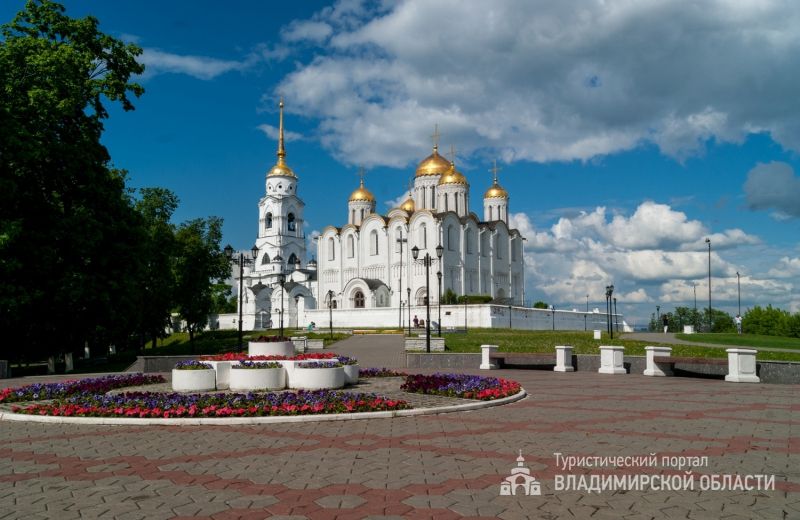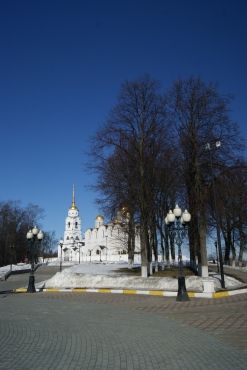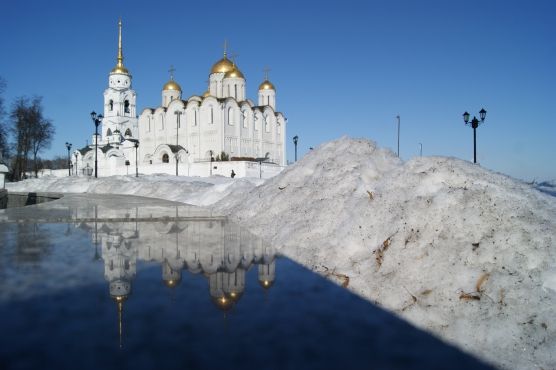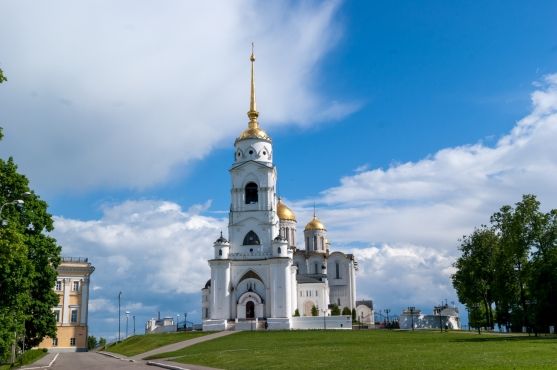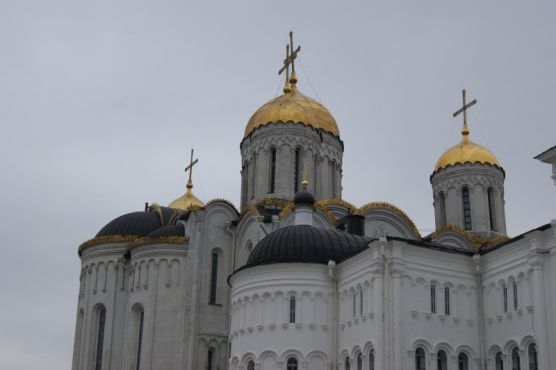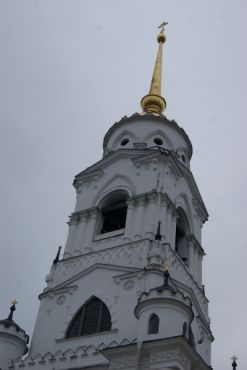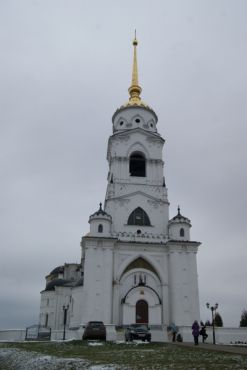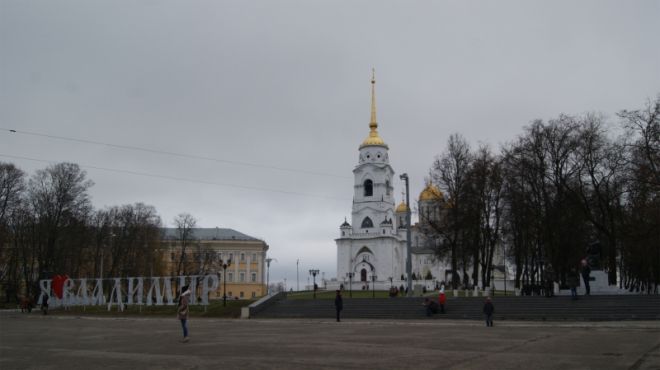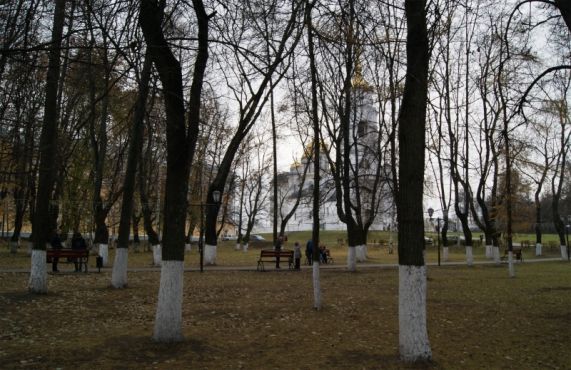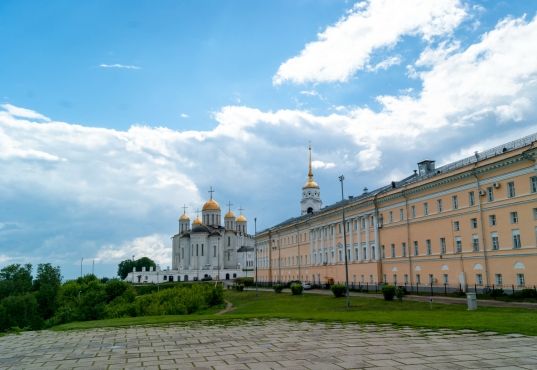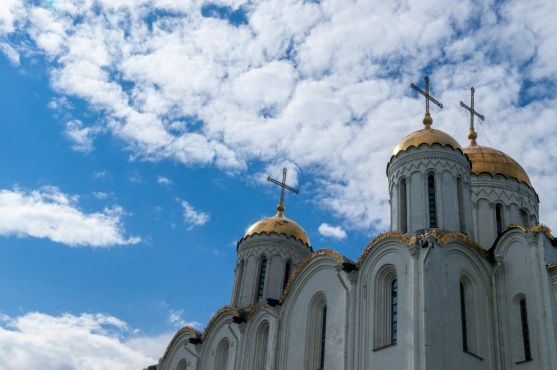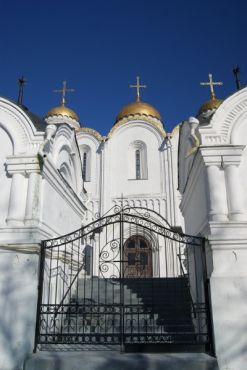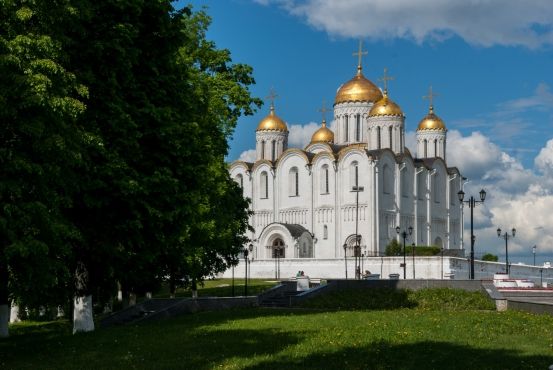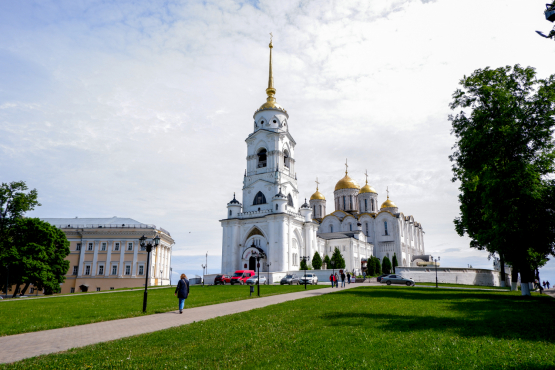Assumption Cathedral
The Assumption Cathedral was the largest building in the framework of the grandiose construction that Andrey Bogolyubsky deployed in the new capital – Vladimir. It occupied the most advantageous point of the city – on the highest hill above Klyazma. Its golden dome was visible from distant approaches to Vladimir and as if asserted the independence of the Vladimir prince and his political claims for supremacy in feudal Russia. The cathedral was laid in 1158, simultaneously with the Golden Gate and the city fortress. And in 1160 the main and the most majestic temple of the principality was already built. Andrei gave the prince's tithes and large landed estates to feed the new church, imitating his famous ancestor, the Baptizer of Russia Vladimir Svyatoslavich, who patronized the Church of the Tithes in Kiev.
For such a large construction, even masters of white stone masonry from the empire of Friedrich Barbarossa were sent to Andrey Bogolyubsky. This was a demonstration of the rejection of Kiev assistance and the establishment of the rule of the Vladimir prince in the Russian land. But without local craftsmen it was indispensable. They mined a calcareous stone in the quarries near Moscow, brought and cut it, laid three-layered walls. The icon of the Mother of God was moved from the Bogolyubov to the built Assumption Cathedral. Andrey Bogolyubsky at one time brought the icon from Vyshgorod near Kiev, when "without his father's will" went to Suzdal land. This icon, later named the Vladimir Mother of God, is the work of a brilliant Byzantine artist, which even now strikes with deep lyricism, the warmth of mother's love for the child and humanity (stored in the church of St. Nicholas in Tolmachi at the Tretyakov Gallery).
However, the present Assumption Cathedral is a monument of two reigns. The one-domed church of Andrey Bogolyubsky was badly damaged by the fire of 1185, so it was difficult to restore it in its former appearance. Therefore, the architects of Vsevolod III the Big Nest, brother of Prince Andrew, in 1185-1189 surrounded it with new walls ("galleries") with four small heads, and the old cathedral appeared as if in a case inside the new building. The walls of the old cathedral were cut through with large arched openings, turning into peculiar internal pillars of a new, vast temple.
A terrible disaster again struck the cathedral in February 1238, when hordes of Khan Baty captured Vladimir, despite the heroic resistance of the inhabitants. Tatars filled the cathedral from inside and outside with wood and set on fire: the princely family, the bishop and part of the townspeople perished on the choir-gallery of the cathedral. However, the building stood, and its main shrine – the miraculous icon of the Vladimir Mother of God, twice saved from the fire, remained unscathed.
Throughout the centuries, the Assumption Cathedral has been repeatedly subjected to fires and plunder, and then to restorations that have introduced many distortions into its ancient appearance. In the first half of the 19th century, a bell tower and a low St. George's church were added to the cathedral.
And what is left of the ancient walls of the temple? From the side of the bell tower on one of the zakomars can be seen the carved figures of the biblical story "Three youths in the fire-place" – reliefs taken from the old walls and laid in the outer lining of the galleries. Female masks (the symbol of the dedication of the church to the Mother of God) and animal masks (a symbol of princely authority) on the sides of the windows are of the same origin.
In the interior of the cathedral in the northern gallery-tomb, there is a fragment of the fresco of 1161 with the image of prophets and peacocks. Several fragments from the fresco painting of 1189 have survived also: two figures – Artemije and Abraham – in the arch framings in the south-western corner of the early Bogolyubsky’s Cathedral, which connects them with the architecture of the temple and the arcuate-columnar decoration of the facades.
The painting of the cathedral, which suffered from the fires, was restored by the great painter Andrey Rublev, sent from Moscow in 1408, along with Daniil Cherniy and his disciples. In fact, they painted the cathedral anew and only adhered to the old approaches in the placement of plots. Up to 300 square meters of the legendary frescoes of the squad of A. Rublev preserved in the Assumption Cathedral. The most significant composition of the Last Judgment on the vault under the choirs is "The Second and Scary Advent of Christ." After the defeat of the Tatar hordes on the Kulikovo field, the country was entering a new rise, the darkness was inferior to the light of hopes. Therefore, on the Rublev’s murals depicting the waiting of the end of the world – unexpected tranquility, images of Judge Christ, the apostles and angels are devoid of rigor. Their faces do not frighten, but are filled with warmth, reminding the faces of ordinary people. Frescos attract and comfort the viewer, asserting the value of justice. Among other fragments of the Rublev’s painting, the "Procession of the Righteous" should be mentioned. The composition "Lono Abrahamovo" symbolically depicts Paradise on the adjacent arch: the forefathers Abraham, Isaac, Jacob in the blooming garden. In all the images, the inner nobility and sincerity of genius come through.
The picturesque decoration of the Assumption Cathedral, created by Andrey Rublev and his team, was completed with the iconostasis, organically inscribed in the temple space, which icons now make up the pride of the Tretyakov Gallery in Moscow and the Russian Museum in St. Petersburg.
The Assumption Cathedral is also a grandiose ancient necropolis. To the northeast corner of the galleries, a sarcophagus was moved with the remains of the first builder of the cathedral, Andrey Bogolyubsky. Nearby – the tomb of his brother and heir, the second builder of the cathedral – Vsevolod III the Big Nest. Since 1923, the reliquary with a part of the relics of the Grand Duke Alexander Nevsky has been stored in the necropolis of the cathedral. Alexander Nevsky was a grandson of Vsevolod III (in 1723, by decree of Peter I, his relics were transferred from the Monastery of the Nativity of the Virgin in Vladimir to St. Petersburg's Alexander Nevsky Lavra). Dozens of grand dukes rest in the sacred depths of the Assumption Cathedral, filling it with a gloomy and solemn atmosphere of the necropolis.
The Assumption Cathedral still impresses with its majesty and beauty. No wonder the Italian architect Aristotle Fioravanti, invited at the end of the 15th century to Moscow for the construction of the buildings of the Moscow Kremlin, was ordered to inspect the Vladimir Assumption Cathedral. Precisely in its image and likeness the grandiose Kremlin Assumption Cathedral was built for the Grand Duke Ivan III.
Now the Assumption Cathedral in Vladimir, a monument of architecture and spiritual beauty, is used jointly by the Vladimir-Suzdal Diocese and the Vladimir-Suzdal Museum-Reserve, which share the time for prayer and for excursions.
The Assumption Cathedral, like other Vladimir-Suzdal white-stone monuments of the 12th-13th centuries, was included in the UNESCO World Heritage List in 1992.
 Tourism portal of the
Tourism portal of the